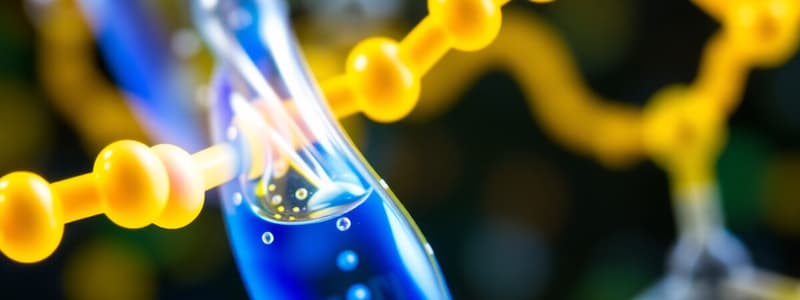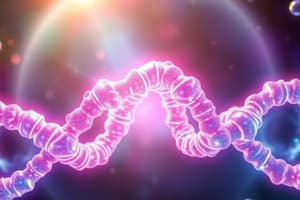Podcast
Questions and Answers
What is the molecular weight of amylase?
What is the molecular weight of amylase?
Which of the following is NOT a tissue source of amylase?
Which of the following is NOT a tissue source of amylase?
What is the role of calcium and chloride in relation to amylase?
What is the role of calcium and chloride in relation to amylase?
Which of the following is NOT a source of error in amylase testing?
Which of the following is NOT a source of error in amylase testing?
What is the specific pancreatic marker mentioned in the text?
What is the specific pancreatic marker mentioned in the text?
Which of the following factors is NOT directly related to amylase activity?
Which of the following factors is NOT directly related to amylase activity?
What is the typical timeframe for elevated amylase levels in acute pancreatitis?
What is the typical timeframe for elevated amylase levels in acute pancreatitis?
What is the primary function of lipase?
What is the primary function of lipase?
Which method is considered the reference method for ALP activity measurement?
Which method is considered the reference method for ALP activity measurement?
Which method is known for its high blank values and long incubation time?
Which method is known for its high blank values and long incubation time?
Which method utilizes a fluorescent substrate and offers improved sensitivity in ALP activity measurement?
Which method utilizes a fluorescent substrate and offers improved sensitivity in ALP activity measurement?
Which of these methods utilize phenyl phosphate?
Which of these methods utilize phenyl phosphate?
Which ALP isoenzyme is inhibited by both L-leucine and phenylalanine?
Which ALP isoenzyme is inhibited by both L-leucine and phenylalanine?
Which of these ALP isoenzymes are increased in biliary tract obstruction?
Which of these ALP isoenzymes are increased in biliary tract obstruction?
Which method is most specific for prostatic ALP activity?
Which method is most specific for prostatic ALP activity?
What do enzyme activity units primarily measure?
What do enzyme activity units primarily measure?
What is the definition of one International Unit (IU) of enzyme activity?
What is the definition of one International Unit (IU) of enzyme activity?
What does the Katal unit (KU) measure in enzymology?
What does the Katal unit (KU) measure in enzymology?
Which statement about enzyme concentration is true?
Which statement about enzyme concentration is true?
What is the primary function of Creatine Kinase?
What is the primary function of Creatine Kinase?
What is the role of the active site in enzyme activity?
What is the role of the active site in enzyme activity?
What is the optimum temperature for enzyme activity as stated?
What is the optimum temperature for enzyme activity as stated?
What occurs at the allosteric site of an enzyme?
What occurs at the allosteric site of an enzyme?
What characterizes isoenzymes?
What characterizes isoenzymes?
In Michaelis-Menten kinetics, what does the Michaelis constant represent?
In Michaelis-Menten kinetics, what does the Michaelis constant represent?
What happens during zero order kinetics?
What happens during zero order kinetics?
What is the physiologic pH range for enzyme activity according to the provided content?
What is the physiologic pH range for enzyme activity according to the provided content?
What does first order kinetics indicate about the relationship between enzyme, substrate, and reaction rate?
What does first order kinetics indicate about the relationship between enzyme, substrate, and reaction rate?
What is the peak time for enzyme elevation in acute pancreatitis?
What is the peak time for enzyme elevation in acute pancreatitis?
Which sample type is predominantly used to assay for enzyme activity related to serum evaluation?
Which sample type is predominantly used to assay for enzyme activity related to serum evaluation?
What is the reference range for the assay of enzyme activity evaluated by hemoglobin?
What is the reference range for the assay of enzyme activity evaluated by hemoglobin?
Which enzyme is a marker for hepatobiliary disease and is predominantly secreted by the liver?
Which enzyme is a marker for hepatobiliary disease and is predominantly secreted by the liver?
What is the purpose of using Cholinesterase in clinical settings?
What is the purpose of using Cholinesterase in clinical settings?
Which method is most commonly used for the assay of Peroxidase?
Which method is most commonly used for the assay of Peroxidase?
What is the source of error associated with LPS stability in serum?
What is the source of error associated with LPS stability in serum?
Which substrate is used in the Cherry Crandall method for the assay of enzyme activity?
Which substrate is used in the Cherry Crandall method for the assay of enzyme activity?
What is the primary function of cofactors in enzymes?
What is the primary function of cofactors in enzymes?
Which classification method is used for enzyme nomenclature?
Which classification method is used for enzyme nomenclature?
How do simple enzymes differ from conjugated enzymes?
How do simple enzymes differ from conjugated enzymes?
What effect does an increase in temperature generally have on enzyme activity?
What effect does an increase in temperature generally have on enzyme activity?
What are apoenzymes specifically referred to as?
What are apoenzymes specifically referred to as?
Which statement correctly defines a coenzyme?
Which statement correctly defines a coenzyme?
How is enzyme activity affected for every 10 degrees increase in temperature?
How is enzyme activity affected for every 10 degrees increase in temperature?
What is the primary role of a holoenzyme?
What is the primary role of a holoenzyme?
Flashcards
Enzyme Concentration
Enzyme Concentration
Refers to the amount of enzyme present in a solution affecting reaction speed.
Enzyme Activity Units
Enzyme Activity Units
Units that measure enzyme quantities based on their reactivity, not absolute amounts.
International Unit (IU)
International Unit (IU)
An IU denotes the amount of enzyme that catalyzes 1µmol of substrate per minute.
Katal Unit (KU)
Katal Unit (KU)
Signup and view all the flashcards
Creatinine Kinase
Creatinine Kinase
Signup and view all the flashcards
Active site
Active site
Signup and view all the flashcards
Optimum temperature
Optimum temperature
Signup and view all the flashcards
Allosteric site
Allosteric site
Signup and view all the flashcards
Isoenzymes
Isoenzymes
Signup and view all the flashcards
Zero order kinetics
Zero order kinetics
Signup and view all the flashcards
First order kinetics
First order kinetics
Signup and view all the flashcards
Michaelis-Menten Constant
Michaelis-Menten Constant
Signup and view all the flashcards
Physiologic pH
Physiologic pH
Signup and view all the flashcards
Enzyme Definition
Enzyme Definition
Signup and view all the flashcards
Coenzyme
Coenzyme
Signup and view all the flashcards
Apoenzyme
Apoenzyme
Signup and view all the flashcards
Holoenzyme
Holoenzyme
Signup and view all the flashcards
Cofactor
Cofactor
Signup and view all the flashcards
Simple Enzymes
Simple Enzymes
Signup and view all the flashcards
Conjugated Enzymes
Conjugated Enzymes
Signup and view all the flashcards
Effect of Temperature
Effect of Temperature
Signup and view all the flashcards
Electrophoretic Properties
Electrophoretic Properties
Signup and view all the flashcards
Heat Stability
Heat Stability
Signup and view all the flashcards
Phenylalanine Inhibition
Phenylalanine Inhibition
Signup and view all the flashcards
Hypophosphatasia
Hypophosphatasia
Signup and view all the flashcards
Biliary Tract Obstruction
Biliary Tract Obstruction
Signup and view all the flashcards
Substrate in ALP Testing
Substrate in ALP Testing
Signup and view all the flashcards
Continuous Monitoring Technique
Continuous Monitoring Technique
Signup and view all the flashcards
Bowers and McComb Method
Bowers and McComb Method
Signup and view all the flashcards
Amylase
Amylase
Signup and view all the flashcards
Calcium and Chloride
Calcium and Chloride
Signup and view all the flashcards
Acinar cells
Acinar cells
Signup and view all the flashcards
Sources of error in amylase testing
Sources of error in amylase testing
Signup and view all the flashcards
Reference range for amylase in serum
Reference range for amylase in serum
Signup and view all the flashcards
Diagnosis of acute pancreatitis
Diagnosis of acute pancreatitis
Signup and view all the flashcards
Lipase
Lipase
Signup and view all the flashcards
Influence of salivary gland lesions
Influence of salivary gland lesions
Signup and view all the flashcards
Acute pancreatitis
Acute pancreatitis
Signup and view all the flashcards
LPS levels
LPS levels
Signup and view all the flashcards
Enzyme elevation timing
Enzyme elevation timing
Signup and view all the flashcards
5' Nucleotidase
5' Nucleotidase
Signup and view all the flashcards
Cholinesterase
Cholinesterase
Signup and view all the flashcards
Dixon & Purdon method
Dixon & Purdon method
Signup and view all the flashcards
Cherry Crandall method
Cherry Crandall method
Signup and view all the flashcards
Sources of error in LPS testing
Sources of error in LPS testing
Signup and view all the flashcards
Study Notes
Enzymes
- Enzymes accelerate chemical reactions in living organisms by lowering the activation energy.
- They are biological catalysts, typically proteins.
- Enzymes are specific to a particular reaction and substrate.
- Enzymes can be categorized based on the reactions they catalyze.
- Enzyme activity can be affected by temperature and pH.
Enzyme Nomenclature
- Enzyme names often include the substrate involved.
- Enzyme class, subclass, and sub-subclass are used to categorize enzymes.
- A final number identifies the specific enzyme within the sub-subclass.
Enzyme Kinetics
- Enzyme-substrate complexes form, lowering activation energy.
- Lock-and-key model: active site has a specific shape for a specific substrate.
- Induced-fit model: active site changes shape to accommodate a substrate.
- Reaction rate depends on substrate concentration, enzyme concentration, temperature, and pH.
- First-order kinetics relates reaction velocity to substrate concentration.
- Zero-order kinetics occurs when the enzyme is saturated with substrate.
- Michaelis-Menten constant (Km) is a measure of substrate affinity for an enzyme.
Enzyme Structure
- Enzymes are composed of amino acids arranged in a specific sequence (primary structure).
- Secondary structures include alpha-helices and beta-pleated sheets.
- Tertiary structure is the overall 3-D shape of the polypeptide chain.
- Quaternary structure arises when multiple polypeptide chains interact.
- Active site: specific region where the substrate binds.
- Allosteric site: another region on the enzyme that can alter enzyme activity.
Enzyme Inhibitors
- Competitive inhibitors resemble the substrate and bind to the active site, blocking substrate binding.
- Noncompetitive inhibitors bind to a site other than the active site, altering enzyme conformation.
- Irreversible inhibitors form covalent bonds with the enzyme, permanently inhibiting activity.
Enzyme Activity Measurement
- Activity is measured by changes in substrate concentration over time, often using spectrophotometry.
- International Units (IU) and Katal (KU) quantify enzyme activity.
Creatinine Kinase (CK)
- CK catalyzes the transfer of a phosphate group between creatine phosphate and adenosine diphosphate.
- Elevated CK levels are associated with muscle damage, myocardial infarction, muscular dystrophy.
- CK exists as isoenzymes, each with different tissue locations.
- CK-MB is clinically significant as a marker for myocardial infarction.
Lactate Dehydrogenase (LDH)
- LDH catalyzes the conversion between lactic acid and pyruvic acid.
- High LDH levels can indicate diverse conditions including muscle damage, heart attacks, infections, and certain cancers.
- LDH isoenzymes differ in their tissue distribution.
Aspartate Aminotransferase (AST)
- AST catalyzes the transfer of an amino group between aspartate and alpha-ketoglutarate.
- Elevated AST levels often indicate liver disease, but can be associated with other conditions including muscle damage and myocardial infarction.
Alanine Aminotransferase (ALT)
- ALT catalyzes the transfer of an amino group between alanine and alpha-ketoglutarate.
- Primarily found in the liver; elevated ALT levels point to potential liver damage or dysfunction.
Alkaline Phosphatase (ALP)
- ALP catalyzes the hydrolysis of phosphomonoesters.
- Elevated ALP is commonly associated with bone diseases, liver disorders, and problems with the biliary tract.
- Different forms (isoenzymes) of ALP exist, each with diverse tissue origins.
Acid Phosphatase (ACP)
- ACP catalyzes the hydrolysis of phosphomonoesters.
- Typically elevated in prostate cancer, but can be associated with other conditions including bone disease, and kidney issues..
- Increased ACP may be seen in cases of cancer.
Gamma-glutamyltransferase (GGT)
- GGT catalyzes transfer of the gamma-glutamyl group.
- Elevated GGT levels can suggest liver problems, but also various other conditions such as kidney disease.
Amylase
- Amylase hydrolyzes starch into smaller sugars.
- High amylase levels are a biomarker for acute pancreatitis, but other inflammatory conditions may account for increased amylase.
Lipase
- Lipase hydrolyzes triglycerides.
- High levels are mainly due to acute pancreatitis, but can occur in cases of several other conditions, including gallstones or tumors..
Glucose-6-phosphate Dehydrogenase (G6PD)
- G6PD catalyzes the oxidation of glucose-6-phosphate to 6-phosphogluconate.
- Deficiencies in G6PD can cause hemolytic anemia.
Additional Information
- Enzyme activity is dependent on substrate, enzyme concentration, Temperature, and pH.
- Enzyme assays are used clinically to diagnose and monitor disease conditions.
Studying That Suits You
Use AI to generate personalized quizzes and flashcards to suit your learning preferences.




